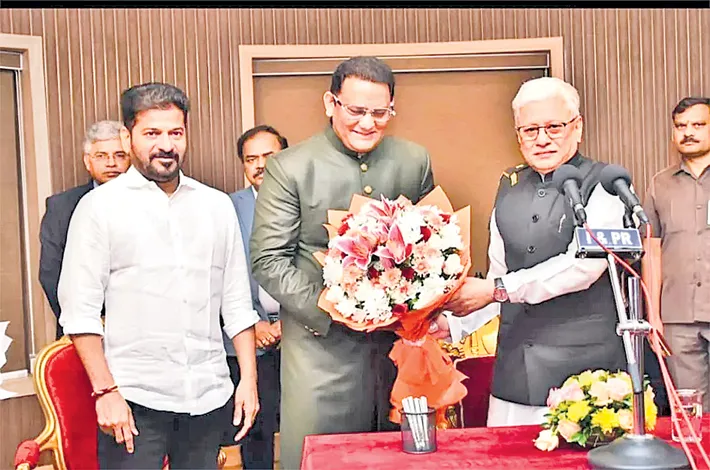Fears abound Electricity Amendment Bill
01-11-2025 12:00:00 AM

The Ministry of Power, Government of India published Draft Electricity (Amendment) Bill-2025 on October 9. Various central government departments and state governments have been asked to send their comments to the ministry within 30 days. At present, most states depend on a single state-owned distribution company (DISCOM), often lacking incentives to curb losses or enhance customer service. The bill proposes allowing multiple DISCOMs—both public and private—to vie for consumers within the same geographic area, with oversight from State Electricity Regulatory Commissions (SERCs).
The Bill dismantles the monopoly model by allowing multiple licensees—government and private—to supply electricity in the same area, regulated by SERCs. Large consumers (over 1 MW demand) can opt for open access, procuring power directly while paying cost-reflective wheeling charges for network use. A novel "Electric Line Authority" under Section 164 empowers licensees to erect lines without the cumbersome Indian Telegraph Act, 1885, streamlining infrastructure rollout. To balance choice with stability, discoms act as "suppliers of last resort." SERCs will enforce performance standards on reliability, voltage, and outages, with penalties for non-compliance, including license revocation.
No rise in bills, assures government
Fears of soaring tariffs are misplaced, the government insists. Competition, it argues, will compel DISCOMs to slash technical losses—currently masked by power theft and transmission inefficiencies—while shared use of existing networks avoids duplicative infrastructure costs. Subsidies for farmers and low-income households will remain intact, with the bill emphasizing transparency and targeted delivery. “By bolstering DISCOM finances, reliance on blanket subsidies will naturally decline, easing state budgets over time,” a senior official added.
A crucial reform introduces cost-reflective tariffs, aligning prices with actual generation and supply expenses. This aims to halt DISCOMs’ practice of selling power below cost and depending on taxpayer-funded bailouts. Crucially, cross-subsidies—where industries shoulder higher rates to offset agricultural and domestic discounts—will shift to direct, budgeted subsidies. Proponents say this will enhance industrial competitiveness, attract investment, and foster a fairer ecosystem. To prevent private players from selectively choosing profitable consumers, State Electricity Regulatory Commissions will impose regulated, cost-reflective charges for network usage, ensuring equitable contributions to maintenance and expansion. A universal service obligation binds all suppliers—public or private—to serve every consumer in their licensed area, not just lucrative segments.
Strengthening renewables and market mechanisms
Amendments to Section 86(1)(e) empower Renewable Purchase Obligations (RPOs) to include non-fossil energy sources like hydro and nuclear. Non-compliance now attracts penalties under a new Section 142(2), enforcing accountability. The Central Electricity Regulatory Commission gains powers to regulate market-based green instruments, such as green energy certificates and time-of-day tariffs, fostering innovation. Captive generation rules are tightened: Central and state governments can frame eligibility criteria, preventing misuse by non-manufacturers. The Central Electricity Authority (CEA) will frame cyber security regulations for the integrated grid, safeguarding against digital threats
Regulatory and institutional overhaul
A new Electricity Council—modeled on the GST Council—will advise on policy, comprising Union and state ministers to build consensus on reforms. Adjudicatory timelines are capped at 120 days (Section 90(2)), and the appellate tribunal for Electricity (APTEL) expands from three to seven members to clear backlogs. Grounds for removing CERC/SERC members are broadened to include negligence, enhancing accountability. Universal Service Obligation (USO) persists: All licensees must serve all consumers without discrimination, with exemptions only for large users. These features collectively aim to inject efficiency into a sector plagued by 22% aggregate technical and commercial (AT&C) losses.
Perceived advantages: fueling growth and sustainability
Supporters, including industry bodies and the government, view the Bill as a one-all cure for the power sector's woes. With India's energy demand projected to double by 2040, these reforms could catalyze a Rs 20 lakh crore investment surge. A Rs 6.9 lakh crore losses for all discoms combined stems from non-cost-reflective tariffs and delayed subsidies, forcing repeated government bailouts via schemes like UDAY (2015).
By mandating cost-based pricing and transparent subsidies, the Bill curtails under-recoveries, potentially slashing AT&C losses to 12-15% within years. States benefit too: Explicit subsidies appear in budgets, curbing off-balance-sheet liabilities and freeing funds for infrastructure. Economists estimate this could save Rs 1-2 lakh crore annually in contingent liabilities, stabilizing state finances.
Accelerating clean energy transition
India's net-zero pledge by 2070 demands 500 GW renewables by 2030. RPO penalties and CERC's green market powers will enforce compliance, where current shortfalls hit 10-15%. Market instruments like green hydrogen certificates could attract $50 billion in RE investments. Captive rules prevent evasion, ensuring genuine self-consumption for industries shifting to solar-wind hybrids. The Electricity Council fosters Centre-state synergy, akin to GST's success in coordinating taxes. Cybersecurity norms protect the smart grid, vital for EV integration and demand response.
Opposition: voices of caution and critique
Threat to federalism and state autonomy Electricity's concurrent list status (Entry 38, List III) demands Centre-state balance. Critics argue the Electricity Council centralizes power, overriding SERCs like GST did taxes—Kerala's Minister termed it an "impingement on states. Tamil Nadu and West Bengal government echo fears of "one-size-fits-all" policies ignoring regional needs, like Punjab's free farm power. Without veto powers, states worry of fiscal impositions amid rising deficits from explicit subsidies.
Privatization fears and service inequity
The Bill's competition clause is seen as a gateway for corporates to "cherry-pick" lucrative urban markets, leaving rural areas to loss-making public discoms. All India Power Engineers Federation (AIPEF) cautioned of "indiscriminate privatization," citing Delhi's experiences where private players hiked tariffs post-efficiency gains. The Electric Line Authority, they claim, grants private entities unchecked land access, evoking eminent domain abuses. Equity suffers: Private focus on profits could widen urban-rural divides, with 40% rural electrification gaps persisting.
Tariff hikes and burden on vulnerable groups
Phasing cross-subsidies alarms farmers and low-income households. In states like Uttar Pradesh, where agriculture gets near-free power, elimination could triple bills—Rs 5-7 per unit hikes for 25 crore farmers. Critics like Peoples Democracy argue subsidies won't be timely, mirroring DBT glitches in PDS. MSMEs, despite exemptions, fear open access favors giants, squeezing small players. Women-led households and informal workers, reliant on subsidized power, face disproportionate hits amid inflation.
Skeptics question enforcement: SERCs, often state-influenced, may delay cost-reflective tariffs, prolonging losses. RPO penalties could cascade to consumers via higher tariffs, not green investments. Allegations of favoring oligarchs—big corporates 40% thermal dominance—fuel "crony" charges. X posts from unions amplify: "Bill benefits corporates, burdens people." Opposition isn't monolithic; even moderates journals like “The Print” urge "politics shouldn't short-circuit reforms," but demand safeguards. Kerala Assembly's 2021 resolution against similar Bills underscores enduring distrust
The Electricity (Amendment) Bill, 2025, is no mere tweak—it's a bold reimagining of India's power paradigm. Its features promise viability and vitality, advantages that could propel Viksit Bharat. Yet, opposition highlights real risks: Federal frictions, privatization pitfalls, and equity erosions. Success hinges on dialogue—via the Electricity Council—and robust safeguards like ring-fenced subsidies and rural mandates. As consultations close, the Bill's fate rests with Parliament. If refined, it could light up progress; if rushed, dim hopes. In a nation where power outages cost 1-2% GDP annually, the choice is clear: Reform wisely, or risk blackout. The grid awaits its upgrade.








